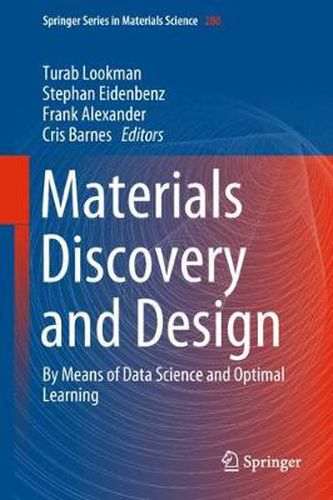Readings Newsletter
Become a Readings Member to make your shopping experience even easier.
Sign in or sign up for free!
You’re not far away from qualifying for FREE standard shipping within Australia
You’ve qualified for FREE standard shipping within Australia
The cart is loading…






This title is printed to order. This book may have been self-published. If so, we cannot guarantee the quality of the content. In the main most books will have gone through the editing process however some may not. We therefore suggest that you be aware of this before ordering this book. If in doubt check either the author or publisher’s details as we are unable to accept any returns unless they are faulty. Please contact us if you have any questions.
This book addresses the current status, challenges and future directions of data-driven materials discovery and design. It presents the analysis and learning from data as a key theme in many science and cyber related applications. The challenging open questions as well as future directions in the application of data science to materials problems are sketched. Computational and experimental facilities today generate vast amounts of data at an unprecedented rate. The book gives guidance to discover new knowledge that enables materials innovation to address grand challenges in energy, environment and security, the clearer link needed between the data from these facilities and the theory and underlying science. The role of inference and optimization methods in distilling the data and constraining predictions using insights and results from theory is key to achieving the desired goals of real time analysis and feedback. Thus, the importance of this book lies in emphasizing that the full value of knowledge driven discovery using data can only be realized by integrating statistical and information sciences with materials science, which is increasingly dependent on high throughput and large scale computational and experimental data gathering efforts. This is especially the case as we enter a new era of big data in materials science with the planning of future experimental facilities such as the Linac Coherent Light Source at Stanford (LCLS-II), the European X-ray Free Electron Laser (EXFEL) and MaRIE (Matter Radiation in Extremes), the signature concept facility from Los Alamos National Laboratory. These facilities are expected to generate hundreds of terabytes to several petabytes of in situ spatially and temporally resolved data per sample. The questions that then arise include how we can learn from the data to accelerate the processing and analysis of reconstructed microstructure, rapidly map spatially resolved properties from high throughput data, devise diagnostics for pattern detection, and guide experiments towards desired targeted properties. The authors are an interdisciplinary group of leading experts who bring the excitement of the nascent and rapidly emerging field of materials informatics to the reader.
$9.00 standard shipping within Australia
FREE standard shipping within Australia for orders over $100.00
Express & International shipping calculated at checkout
This title is printed to order. This book may have been self-published. If so, we cannot guarantee the quality of the content. In the main most books will have gone through the editing process however some may not. We therefore suggest that you be aware of this before ordering this book. If in doubt check either the author or publisher’s details as we are unable to accept any returns unless they are faulty. Please contact us if you have any questions.
This book addresses the current status, challenges and future directions of data-driven materials discovery and design. It presents the analysis and learning from data as a key theme in many science and cyber related applications. The challenging open questions as well as future directions in the application of data science to materials problems are sketched. Computational and experimental facilities today generate vast amounts of data at an unprecedented rate. The book gives guidance to discover new knowledge that enables materials innovation to address grand challenges in energy, environment and security, the clearer link needed between the data from these facilities and the theory and underlying science. The role of inference and optimization methods in distilling the data and constraining predictions using insights and results from theory is key to achieving the desired goals of real time analysis and feedback. Thus, the importance of this book lies in emphasizing that the full value of knowledge driven discovery using data can only be realized by integrating statistical and information sciences with materials science, which is increasingly dependent on high throughput and large scale computational and experimental data gathering efforts. This is especially the case as we enter a new era of big data in materials science with the planning of future experimental facilities such as the Linac Coherent Light Source at Stanford (LCLS-II), the European X-ray Free Electron Laser (EXFEL) and MaRIE (Matter Radiation in Extremes), the signature concept facility from Los Alamos National Laboratory. These facilities are expected to generate hundreds of terabytes to several petabytes of in situ spatially and temporally resolved data per sample. The questions that then arise include how we can learn from the data to accelerate the processing and analysis of reconstructed microstructure, rapidly map spatially resolved properties from high throughput data, devise diagnostics for pattern detection, and guide experiments towards desired targeted properties. The authors are an interdisciplinary group of leading experts who bring the excitement of the nascent and rapidly emerging field of materials informatics to the reader.